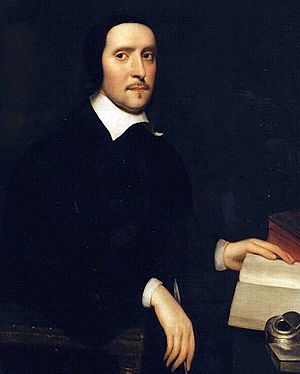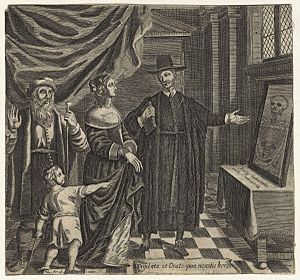Jeremy Taylor facts for kids
Quick facts for kids |
|
|---|---|
| Bishop of Down and Connor | |

Taylor as depicted in a portrait at Gonville and Caius College, Cambridge
|
|
| Church | Church of Ireland |
| Diocese | Down and Connor |
| In Office | 1661–1667 |
| Predecessor | Henry Leslie |
| Successor | Roger Boyle |
| Orders | |
| Consecration | 27 January 1661 |
| Personal details | |
| Born | 1613 |
| Died | 13 August 1667 (aged 53–54) |
| Nationality | English |
| Denomination | Anglicanism |
| Education | Perse School |
| Alma mater | Gonville and Caius College, Cambridge |
| Sainthood | |
| Feast day | 13 August |
| Venerated in | Church of England Episcopal Church |
Jeremy Taylor (1613–1667) was an important writer and church leader in England. He lived during a time when England was ruled by Oliver Cromwell. People sometimes called him the "Shakespeare of Divines" because his writing was so beautiful and poetic. He is still remembered today in the Church of England and the Episcopal Church.
Taylor was supported by William Laud, who was the Archbishop of Canterbury. Because of Laud's help, Taylor became a chaplain to King Charles I. This made him a target when Laud was put on trial and executed in 1645 by the Puritan parliament during the English Civil War. After the King's side lost the war, Taylor was put in prison a few times.
Later, he was allowed to live quietly in Wales. There, he worked as a private chaplain for the Earl of Carbery. When the King was restored to power in England, Taylor was made a Bishop of Down and Connor in Ireland. He also became a leader at the University of Dublin.
Contents
Jeremy Taylor's Early Life
Taylor was born in Cambridge, England, in 1613. His father, Nathaniel, was a barber but was also educated. He taught Jeremy grammar and math at home. Jeremy then went to the Perse School in Cambridge.
After school, he studied at Gonville and Caius College at Cambridge University. He earned his first degree in 1630 or 1631 and a Master of Arts degree in 1634. He was a very hardworking student. This helped him become very knowledgeable later in life.
In 1633, even though he was still quite young, he became a priest. He was asked to give lectures at St Paul's Cathedral for a short time.
Working for Archbishop Laud
Archbishop William Laud heard Taylor preach and was very impressed. Laud decided to help the young man. Taylor spent a lot of time in London, as Laud wanted him to have good chances to study.
In 1635, Laud helped Taylor get a special position at All Souls College, Oxford. People at Oxford admired him greatly. He became a chaplain for Archbishop Laud and also for King Charles I.
While at Oxford, Taylor might have learned about new ideas from William Chillingworth. In 1638, Taylor became the priest of Uppingham in Rutland. He settled down to work as a country priest there.
In the next year, he married Phoebe Langsdale. They had six children together. In the autumn of that year, he gave a sermon at St Mary's. He used this chance to clear up rumors that he secretly supported the Roman Catholic Church. These rumors might have started because he was friends with a Franciscan friar named Christopher Davenport. His close ties to Laud and his strict religious habits also made people suspicious.
Taylor supported the King's side during the English Civil War. Because of this, he lost his parish in 1644. He likely joined the King in Oxford. In 1643, King Charles I gave him another church job in Overstone, Northamptonshire.
A Royalist Prisoner
For the next 15 years, it's hard to know exactly where Taylor was all the time. He was probably in London when King Charles I was executed in 1649. It's said the King gave him his watch and some jewels.
In 1645, Taylor was captured with other Royalists during the siege of Cardigan Castle. In 1646, he worked with two other priests who had lost their jobs. They ran a school in Carmarthenshire, Wales. While there, he became a private chaplain for Richard Vaughan, 2nd Earl of Carbery. Taylor lived at the Earl's home, Golden Grove, which he later named a famous prayer book after. He wrote some of his best works there.
Taylor's first wife died in 1651. He then married Joanna Bridges. She was said to be a daughter of King Charles I, but there is no strong proof of this. She owned land in Carmarthenshire. A few years after they married, they moved to Ireland.
Taylor was put in prison three times. In 1645, it was for something he wrote in his Golden Grove book. In 1655, he was held in Chepstow Castle. In 1657, he was imprisoned in the Tower of London. This last time was because his publisher had put a picture of Christ praying on the cover of one of his books.
Jeremy Taylor's Writings
Jeremy Taylor wrote many important books. His book The Rule and Exercises of Holy Living is a guide for Christians on how to live a good life. It teaches about being virtuous and avoiding bad habits. It also includes prayers.
Holy Dying was another very popular book. It talks about how to prepare for death in a Christian way. A lighter book he wrote was Discourse of the Nature, Offices and Measures of Friendship (1657). He wrote this for his friend, Mrs. Katherine Phillips, who asked if strong friendships were allowed by Christian rules.
His book Ductor Dubitantium, or the Rule of Conscience … (1660) was meant to be a guide for Christians on how to make moral choices. Some of his works were even translated into the Welsh language.
Bishop in Ireland
Taylor likely left Wales in 1657. In 1658, his friend John Evelyn helped him get a teaching job in Lisburn, Ireland. At first, Taylor didn't want the job because he would have to share duties with a Presbyterian minister. He also thought the pay was too low. But he eventually took the job and found a peaceful place to live at Portmore, near Lough Neagh.
When the King was restored to power in England, Taylor was made the Bishop of Down and Connor in Ireland. Soon after, he also became responsible for the nearby diocese of Dromore. As bishop, he ordered a new cathedral to be built in Dromore in 1661. He also became a member of the King's special council in Ireland and a leader at the University of Dublin. These were all very demanding jobs.
Taylor worked hard to set rules for the university and create new teaching positions. His work as a bishop was even harder. In northern Ireland, there were about 70 Presbyterian ministers. Most of them came from Scotland and strongly disliked the idea of bishops. Taylor felt like he was "thrown into a place of torment."
Taylor wanted the Presbyterian clergy to accept bishops and his authority. When they refused, he declared 36 churches to be empty and took them back. However, many local leaders were impressed by his honesty and dedication. He was less successful with the Roman Catholic people. They did not speak English and preferred their traditional worship. They were forced to attend services they did not understand.
During this time, he married his second wife, Joanna Brydges. They had two daughters, Mary and Joanna. Mary later married Bishop Francis Marsh.
Jeremy Taylor died in Lisburn on August 13, 1667. He was buried at Dromore Cathedral. The Church of England and the Episcopal Church remember him on August 13.
Family Life
It is believed that Jeremy Taylor was a direct descendant of Rowland Taylor, but this has not been fully proven. Through his daughter Mary, who married Archbishop Francis Marsh, he has many descendants today.
Main Books and Publications
- A Discourse of the Liberty of Prophesying (1646): This book argued for religious tolerance. It was written many years before John Locke wrote similar ideas.
- Apology for Authorised and Set Forms of Liturgy against the Pretence of the Spirit (1649)
- Great Exemplar … a History of … Jesus Christ (1649)
- The Rule and Exercises of Holy Living (1650)
- The Rule and Exercises of Holy Dying (1651)
- Twenty-seven Sermons Preached at Golden Grove, for the Summer Half-year … (1651)
- Twenty-five Sermons Preached at Golden Grove, for the Winter Half-year … (1653)
- Clerus Domini: or, A Discourse of the Divine Institution, Necessity, Sacrednesse, and Separation of the Office Ministerial (1651)
- The Real Presence and Spirituall of Christ in the Blessed Statement Proved Against the Doctrine of Transubstantiation. (1654)
- Golden Grove; or a Manuall of Daily Prayers and Letanies … (1655)
- Unum Necessarium (1655): This book was about repentance. Some people, especially Presbyterians, found some of its ideas offensive.
- Discourse of the Nature, Offices and Measures of Friendship (1657)
- Ductor Dubitantium, or the Rule of Conscience … (1660)
- The Worthy Communicant; or a Discourse of the Nature, Effects, and Blessings consequent to the worthy receiving of the Lords Supper … (1660)
- Contemplations of the state of man in this life and in that which is to come (1684)
Images for kids



